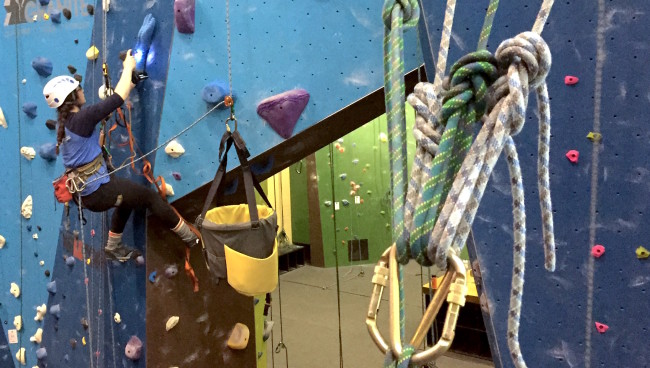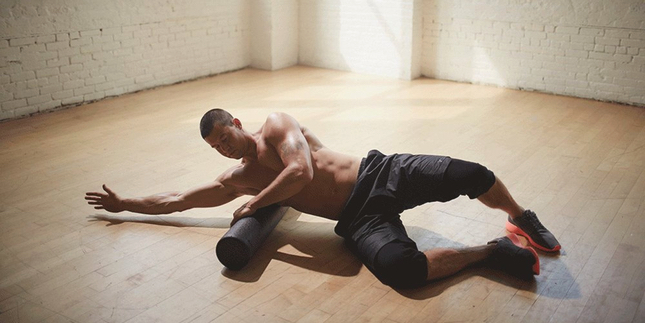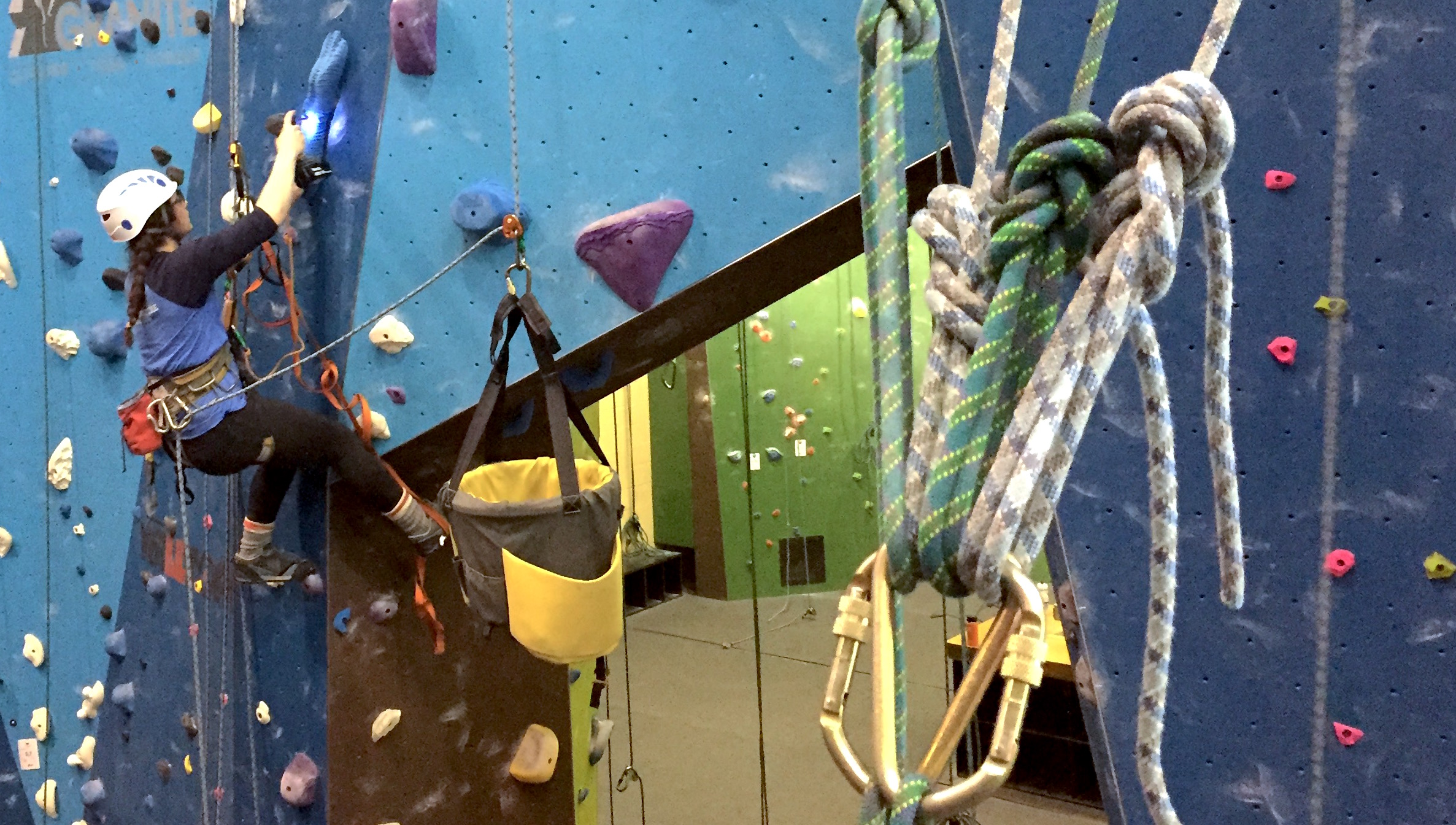
By Rylan Marshall
Too many climbers are familiar with the recurring twinges of elbow tendonitis or the pangs of myriad finger maladies. A seasoned setter can add to this list of maladies lower back and leg problems from hanging in a harness for prolonged periods, knee and ankle problems from standing on unstable padded floors, shoulder and neck problems from constantly working overhead, and wrist problems from hoisting heavy tools and holds, among many other minor tweaks and chronic injuries.
There is no doubt that routesetting is a hard job. As ‘industrial athletes’, the physical demands of the job present challenges that can make it difficult for a setter to stay healthy, motivated and strong. This does not mean, however, that it is impossible, and while the industry is rather young there are a few setters who have been involved long enough to have solved the riddle of injury prevention while being a full time routesetter and climbing hard.
Safety First
There are a number of risks that are an inherent part of a routesetter’s job due to the nature of working with tools on ladders or on rope, moving and hoisting heavy climbing holds and volumes, and sometimes operating sharp tools in confined spaces behind the wall. Helmets, ear protection, safety glasses, and work gloves should be part of any setter’s kit as they are tools essential to avoiding serious, traumatic injuries.
However, subtle injuries, most commonly related to overuse, are more difficult to address and are far more prevalent. A setter of 21 years, Molly Beard, USAC Level 5 National Chief and Head Setter of the Multnomah Athletic Club in Portland, Oregon, is no stranger to aches and pains. “When injuries first popped up it was more or less classic overuse, and [a result of] being young and feeling like you’re invincible,” Beard said. “‘Why would I bother stretching? Why would I bother doing PT?’ Then you get your first injury and realize you’re mortal and that’s when I started paying attention.”
Paying attention can mean different things to different people. For some, a stronger focus on posture and technique might be enough to stave off injury. For others, a detailed, consistent warmup routine could be the key to accessing maximum physical power without inviting pain. It is essential to assess yourself and explore what your body needs to function at its best. “The number one thing that helped me is, when we’re setting we don’t try the moves,” said Jeremy Hardin, a USAC Level 5 National Chief and Head Setter at Sport Rock in Virginia. “I’m not talking climbing the problem, I’m talking pulling on grips or stepping off the ladder. I never do any of that without being fully warmed up.”
Beard adds that routesetting sometimes requires more climbing than is preferred, particularly at high level competition events. “Smart climbers or routesetters will try not to climb more than three days in a row, but at Divisionals or Nationals you don’t have a choice, you’re climbing four or five days in a row,” she said. “So the biggest thing is make sure you are warm, make sure you do all the little things to make that better. There are all kind of things that are useful to speed recovery from day to day.”
Take Care of Yourself
Mercedes Pollmeier, certified Strength and Conditioning Specialist with a degree in Human Movement, supports that sentiment and suggests incorporating mobility exercises into a daily routine. “If you do mobility work you will set yourself up to move better when you are setting,” she says.
Bad posture is the primary injury culprit for climbers and setters, as unbalanced muscle groups lead to poor form when executing overhead maneuvers. “If you aren’t strong enough to hold the drill above your head for that long you end up getting into really bad positions while you are putting holds on the wall,” Pollmeier adds. Overdeveloped lats and tight pecs, a common climber condition, can cause shoulder impingement, which, if left unchecked, can lead to serious problems.
Preventative maintenance is critical to mitigating the effects of commercial routesetting. The ubiquitous foam roller, along with resistance bands and massage balls, are as important as an impact wrench in a setter’s work kit. Additionally, regularly scheduled bodywork is something to consider. “I get a deep tissue massage every 46 weeks, and that’s probably the biggest thing,” Beard says. “Chiropractic work as needed, that can be every two weeks or two months, whatever is going on at the time.”
Historically, setters have been on their own to take care of themselves, and many neglect to do so until it is either too late or they are out of industry. As routesetting progresses as a career path and routesetters acquire more experience, certifications, and clout, many gyms now understand the importance of keeping their setters healthy and are ahead of the curve in providing programs to keep them able bodied and productive.
The Front now offers punch passes for their full time setters, allowing them monthly access to professional bodywork. Mesa Rim in San Diego, CA has a weekly yoga class specifically designed for its setters. The forward thinking Seattle Bouldering Project has contracted Pollmeier to construct a maintenance and training program for their setting crew.
Though it is still in the works, Pollmeier hints at the scope of her program. “SBP has agreed that the setters can do the mobility work as a part of their day, so the things that I have made up for them is really only 10-15 minutes of warmup and then a little bit at the end of the day. It’s a rehab program so that they don’t get injured setting but they are also gaining strength so that they can do better outside.” While it is ultimately up to the individual to participate in these programs, the mere fact that gyms are willing to provide such support for their setters is a welcome progression and a sign that even better developments are on the horizon.

Work Smarter, Work Efficiently
Age catches up to everyone eventually, and while some may see the inevitable physical decline as a death knell for athletic performance, those that are truly dedicated learn to compensate by utilizing their greatest strength: the mind. The more work you do with your mind, the less work you have to do with your body and the longer you will remain in the game.
It starts with picking the right grips. By choosing holds that are grade and wall appropriate, a setter avoids making multiple trips to the hold closet, thereby reducing wasted time and energy. Furthermore, bringing a few extra grips insures a setter will not run out of holds and will have options for swapping holds during the forerunning process, a sentiment expressed by Jeremy Hardin. “I hate going back to the hold pile. I want to get everything in one motion; set it, tweak it, done,” he says. “If I know I’m setting a V0 on a flat wall I grab holds accordingly. It should be hard for me not to set a V0 with those holds.”
Knowing what to do with the holds that have been selected is the next step, one where many setters get off track. “The ability to visualize what you want to do with the holds and the wall, and to lay that out on the ground and know ‘that hold there, that footchip there’ is one piece of it,” implores Beard.
She specifies that visualization is a learned skill and stresses its importance by adding, “Testing moves and playing with moves doesn’t amount to efficient setting in the long run. Putting the right hold in the right place the first time is critical.” The bulk of a setter’s work is on the wall, which makes the forerunning process easier and more efficient, therefore taxing the body less and leaving more in the tank for other, more personal climbing endeavors.
Playing with moves too much while setting is a bad habit for a setter to fall into, and one that can have physical ramifications in the form of increased harness time. Beard and Hardin are staunch supporters of this theory. “When I have to set in a harness I do every single thing I can to minimize how much time I have to sit in a harness,” Beard says. “My rule is you want to be in that harness absolutely as little as possible, and you want to hang nothing off your harness except for the bare minimum you can get away with.”
She suggests rigging your hold bucket to another line or anchoring it to the wall, while Hardin takes a slightly different approach, preferring to set almost entirely off of a ladder. Whatever the method, the goal is the same: save your body, hang less.
Some harness time is unavoidable, and a setter should be in possession of a beefy harness that provides as much support as possible. Harnesses such as the Metolius Waldo and Black Diamond Big Gun have been old standbys, though some setters are making the switch to arborist harnesses, like the Petzl Sequoia, which are designed to provide even more support and functionality than a traditional climbing harness, and can couple with a removable chest harness for setting the steepest terrain.
Training Balance
Even if routesetting professionals figure out how to stay healthy on the job, many have the additional challenge of needing to balance work with training for outdoor projects or indoor competitions. This can be complicated by a work schedule that requires climbing outside of a structured training routine. The nature of forerunning often requires a setter to climb more consecutive days than is ideal, and the risk of overuse injuries always lurks on the horizon. Still, there are ways to manage schedule constraints, and as with any worthwhile pursuit, dedication is key.
“I train between 5:30am and 9:00am three or four times per week,” says Shane Messer, Director of Setting at Central Rock Gym, father of one, and dedicated competitor. “Being a father, a boyfriend, a routesetter, a climber, and trying to maintain a healthy relationship with your friends, well, something has to give. Coming up with a schedule and trying to stick to it is the most important thing.”
Having a goal or objective is the crucial element to constructing a training plan, and Messer, a gifted route climber and strong boulderer, relies on a periodization program designed to bring him close to his goal: performing well at the USAC Sport Open National Championship. Having this goal allows Shane to remain dedicated to his program, despite the sacrifices it requires. “It will squeeze roughly every free second I have,” he declares, “but a good result in the only rope competition I can compete in would be worth it.”
Time may be a precious resource for Messer, but by utilizing forerunning as a means of climbing specific training, he is able to wring every ounce of time out of a tight schedule. “Three of the four setters I work with are also training for Nationals, so we try to be as strategic as we can be about the forerunning process. With only a few hard routes or problems to climb each day, it definitely makes training more bearable.” Alternating months of endurance and power endurance training are supplemented by steady cardio and weightlifting, with a focus on antagonist muscle groups to avoid overuse injuries.
Mike Bockino, Head Setter at The Front in Salt Lake City and stalwart developer of double digit boulders, designed a training plan focused on outdoor objectives that incorporates his heavy setting workload. “I train three days a week and that varies from power training, finger strength training and fitness training. A lot of the training I do is general body maintenance that helps with keeping healthy.”
Bockino advises taking a break of several hours between setting and training and emphasizes the importance of proper hydration and caloric intake, which seems like obvious advice until you witness firsthand the number of setters who ignore the needs of the body in order to pursue more pertinent objectives.
Being realistic with goals and abilities is one method endorsed Beard. “If I’m focusing my fitness on being able to effectively forerun at a rope national, that is a whole different training scheme than if I was interested in being fit for outdoor bouldering. Those two goals don’t exist together, so there was definitely a degree of selecting outdoor goals that would match the training I was doing for work.”
Bockino, too, is realistic about his abilities. “Generally my level of power climbing ability is low because I never have enough time to rest and recover,” he says. “On the flipside of that, my power endurance is amazingly high because on an average setting day you’re forerunning for two straight hours.”
There are other, less obvious difficulties a setter faces in pursuing outdoor goals. The constant transition from plastic to rock to plastic again doesn’t do the skin any favors, and it can be a challenge to maintain climbable skin under the constant flux of conditions and friction. Bockino has a trick for that, too. “I don’t really get my hands wet. Dishes, showering, everything, I wear gloves. It’s not enjoyable but it works and if you’re trying to go rock climbing on the weekends and you set three or four days a week, it’s the only thing that keeps your skin from falling apart.”
The Long Haul
Routesetting is a growing field and though there are relatively few who have made it a full-time career, there are more on the way. The physical nature of the job is undeniable and is an issue that becomes more prevalent as a setter ages. However, the growth of the industry will provide paths for those with the desire and drive to make it happen.
In order to get to that point, though, a setter has to stay setting and stay healthy. On the front, Beard says it best, reiterating the importance of taking care of yourself. “If it’s something that you are passionate about doing, you have to look long term. It’s a physical job and you gotta take care of the moneymakers or you’re not doing the job.”

Climbing Business Journal is an independent news outlet dedicated to covering the indoor climbing industry. Here you will find the latest coverage of climbing industry news, gym developments, industry best practices, risk management, climbing competitions, youth coaching and routesetting. Have an article idea? CBJ loves to hear from readers like you!






